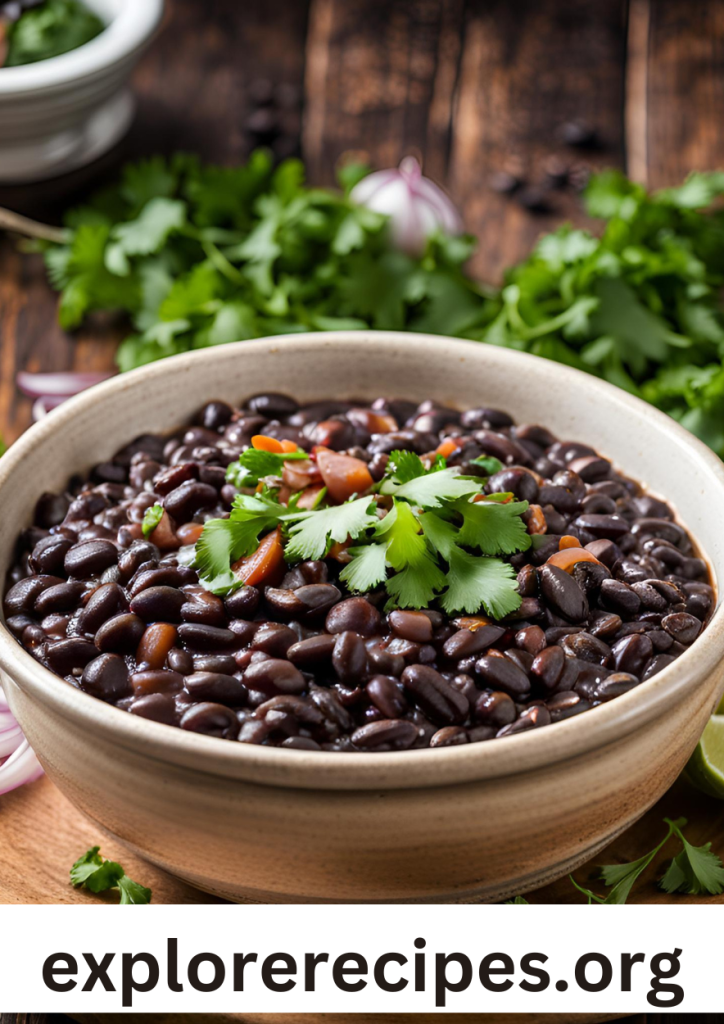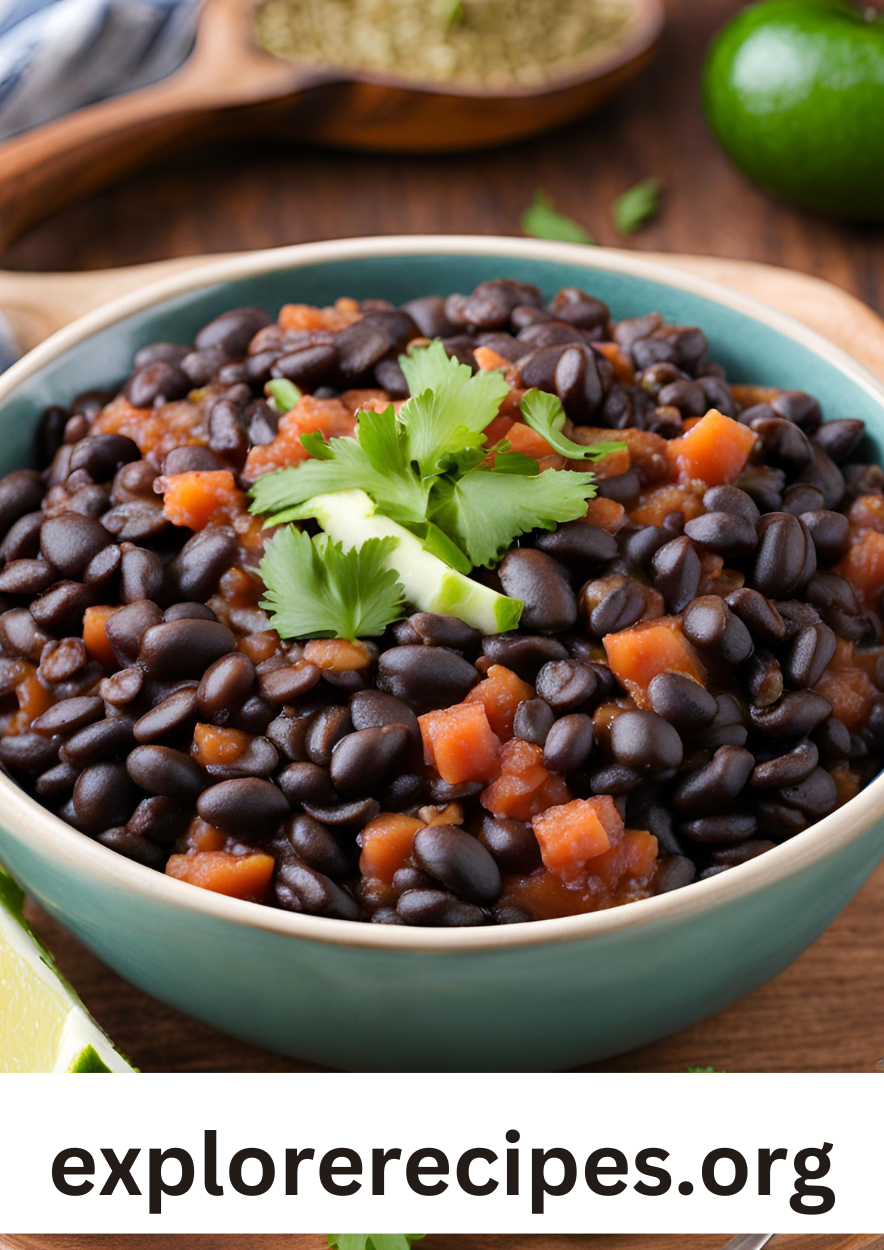Puerto Rican Style Stewed Black Beans (Habichuelas Negras)
Introduction
Puerto Rican cuisine is a vibrant blend of flavors, colors, and textures, with influences from Spanish, African, and Taino culinary traditions. One of the staple dishes in Puerto Rican households is habichuelas negras guisadas, or stewed black beans. This hearty and flavorful dish is packed with spices, aromatics, and traditional seasonings that elevate simple black beans into a rich and satisfying meal. Whether served with white rice, alongside roasted meats, or as a standalone dish, Puerto Rican-style black beans are a must-try for any lover of Caribbean cuisine.
In this blog post, we’ll dive into the essential ingredients, cooking techniques, and tips to make the best stewed black beans.

The Importance of Beans in Puerto Rican Cuisine
Beans (habichuelas) are a fundamental part of Puerto Rican cooking. While red kidney beans (habichuelas coloradas) are more commonly used, black beans (habichuelas negras) also have a special place in the island’s culinary landscape. They are not only nutritious, offering an excellent source of plant-based protein, fiber, and essential vitamins, but also incredibly delicious when slow-cooked with the right seasonings.
The beauty of Puerto Rican-style black beans lies in the sofrito, a traditional aromatic base made from onions, garlic, peppers, and herbs, which forms the foundation of many Puerto Rican dishes. Combined with the right blend of spices and cooking techniques, these beans become rich, creamy, and full of depth.
Key Ingredients for Authentic Puerto Rican Stewed Black Beans
To achieve the traditional flavor of habichuelas negras guisadas, you’ll need the following ingredients:
- Canned or dried black beans – If using dried beans, they need to be soaked overnight and simmered until tender.
- Sofrito – A blend of onions, garlic, bell peppers, culantro (or cilantro), and tomatoes.
- Olive oil – Used to sauté the sofrito and enhance the dish’s richness.
- Adobo seasoning – A staple seasoning blend in Puerto Rican cooking.
- Sazón – A seasoning mix that adds color and depth.
- Bay leaves – For a mild, earthy aroma.
- Tomato sauce or paste – Adds sweetness and richness to the beans.
- Vegetable or chicken broth – To create a flavorful base.
- Cumin and oregano – Essential for the perfect balance of warmth and earthiness.
- Vinegar – A small splash brightens the flavors and enhances the taste.
- Salt and black pepper – To season to taste.
Optional add-ins include diced potatoes, pumpkin, or a splash of coconut milk for a creamy texture.
Step-by-Step Cooking Instructions
1. Prepare the Sofrito
If you don’t already have sofrito prepared, start by blending together the following ingredients:
- ½ onion (chopped)
- ½ bell pepper (chopped)
- 3 cloves garlic
- ¼ cup cilantro or culantro
- 1 small tomato
Blend until smooth or finely mince everything by hand. This sofrito will be the foundation of the dish.
2. Sauté the Aromatics
- Heat 2 tablespoons of olive oil in a large pot over medium heat.
- Add ¼ cup of sofrito and cook for 3-4 minutes until fragrant.
- Stir in 1 teaspoon of cumin, 1 teaspoon of oregano, and 1 bay leaf.
- Add 1 tablespoon of tomato sauce and cook for another minute.
3. Add the Black Beans
- If using canned beans, drain and rinse two 15-ounce cans of black beans.
- Add them to the pot along with 1 cup of vegetable or chicken broth.
- Stir in ½ teaspoon of sazon and ½ teaspoon of adobo seasoning.
4. Simmer and Thicken
- Bring the mixture to a low simmer and cook for 20-25 minutes, stirring occasionally.
- If the beans appear too thick, add a bit more broth; if too thin, let them simmer uncovered until they reach your desired consistency.
- Taste and adjust seasoning as needed, adding salt, black pepper, or a splash of vinegar for balance.
5. Serve and Enjoy!
Puerto Rican black beans pair best with white rice (arroz blanco), but they also complement grilled meats, fried plantains, or tostones. Garnish with fresh cilantro for an extra burst of flavor.
Tips for the Best Puerto Rican Black Beans
- Use Fresh Sofrito – Store-bought sofrito works in a pinch, but homemade gives a fresher and more authentic taste.
- Let the Flavors Develop – Simmering the beans for longer allows the seasonings to blend perfectly.
- Adjust Consistency – If the beans are too thick, add more broth; if too thin, mash some beans to create a creamy texture.
- Experiment with Add-Ins – Add diced potatoes, pumpkin, or even a piece of smoked ham for extra depth.
- Pair with Classic Puerto Rican Dishes – Serve these beans with arroz con gandules, pernil (roast pork), or pasteles for a full Puerto Rican feast.
Nutritional Benefits of Black Beans
Beyond their delicious taste, black beans are a nutritional powerhouse. They are high in fiber, which supports digestion and heart health, and rich in plant-based protein, making them an excellent option for vegetarians and vegans. Additionally, black beans provide iron, folate, and antioxidants, all of which contribute to overall well-being.
Final Thoughts
Puerto Rican-style habichuelas negras guisadas are more than just a side dish—they’re a flavorful, hearty, and deeply rooted part of Puerto Rican cuisine. With the perfect balance of spices, sofrito, and slow-cooked goodness, these stewed black beans are sure to become a favorite in your home.
Give this recipe a try, and experience the warmth and richness of Puerto Rican cooking in every bite!







